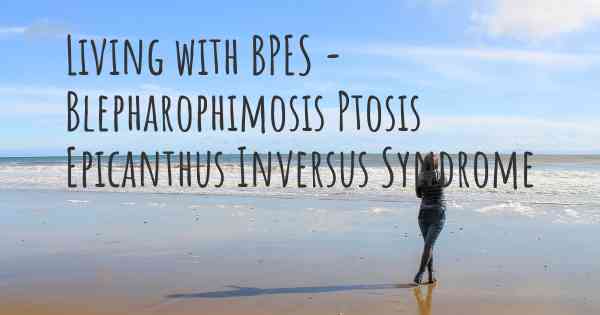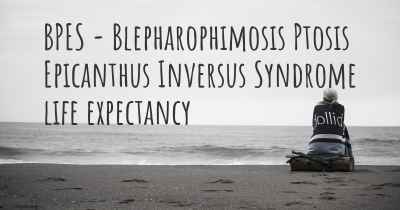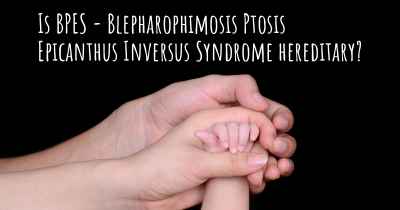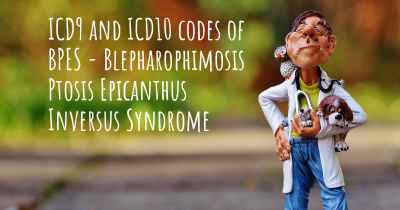Living with BPES - Blepharophimosis Ptosis Epicanthus Inversus Syndrome. How to live with BPES - Blepharophimosis Ptosis Epicanthus Inversus Syndrome?
Can you be happy living with BPES - Blepharophimosis Ptosis Epicanthus Inversus Syndrome? What do you have to do to be happy with BPES - Blepharophimosis Ptosis Epicanthus Inversus Syndrome? Living with BPES - Blepharophimosis Ptosis Epicanthus Inversus Syndrome can be difficult, but you have to fight to try to be happy. Have a look at things that other people have done to be happy with BPES - Blepharophimosis Ptosis Epicanthus Inversus Syndrome

Living with BPES - Blepharophimosis Ptosis Epicanthus Inversus Syndrome
Blepharophimosis Ptosis Epicanthus Inversus Syndrome (BPES) is a rare genetic disorder that affects the development of the eyelids and surrounding structures. Individuals with BPES may experience a combination of eyelid abnormalities, including narrow eye openings (blepharophimosis), droopy eyelids (ptosis), and inwardly folded eyelid corners (epicanthus inversus).
Diagnosis and Understanding
Diagnosing BPES typically involves a thorough examination of the affected individual's eyes and facial features. Genetic testing may also be conducted to confirm the presence of specific gene mutations associated with BPES. It is important to consult with a healthcare professional or genetic specialist to receive an accurate diagnosis and better understand the condition.
Medical Management
While there is no cure for BPES, various medical interventions can help manage the symptoms and improve quality of life. Corrective eyelid surgery is a common treatment option to address the eyelid abnormalities. This surgical procedure aims to widen the eye openings, lift the droopy eyelids, and correct the inwardly folded corners. The surgery is typically performed by an ophthalmologist or a plastic surgeon with expertise in oculoplastic procedures.
Visual Support
Individuals with BPES may experience visual impairments due to the eyelid abnormalities. Regular eye examinations and vision screenings are essential to monitor and address any potential vision issues. Prescription glasses or contact lenses may be prescribed to correct refractive errors and improve visual acuity. Additionally, eye exercises and vision therapy may be recommended to enhance eye coordination and strengthen visual skills.
Psychological and Emotional Support
Living with BPES can present unique challenges, both physically and emotionally. It is important to seek psychological support to cope with any feelings of self-consciousness, anxiety, or depression that may arise. Connecting with support groups or counseling services can provide a safe space to share experiences, gain insights, and receive emotional support from others facing similar challenges.
Education and Advocacy
Education plays a crucial role in understanding BPES and its impact on daily life. Individuals with BPES, their families, and caregivers should actively seek information about the condition, available resources, and support networks. Advocacy for increased awareness and research funding can help drive advancements in medical understanding, treatment options, and support services for individuals living with BPES.
Building a Supportive Network
Creating a strong support network is vital for individuals with BPES. Surrounding yourself with understanding family members, friends, and healthcare professionals can provide the necessary emotional and practical support. Engaging with organizations and online communities dedicated to BPES can also offer valuable connections, information sharing, and a sense of belonging.
Self-Care and Confidence
Practicing self-care and nurturing self-confidence are essential aspects of living with BPES. It is important to prioritize overall well-being, including physical, emotional, and mental health. Engaging in activities that bring joy, pursuing hobbies, and setting achievable goals can contribute to a positive mindset and increased self-esteem.
Conclusion
Living with BPES may present challenges, but with proper medical management, support, and self-care, individuals with BPES can lead fulfilling lives. Seeking professional guidance, connecting with support networks, and maintaining a positive outlook are key to navigating the journey with BPES.








